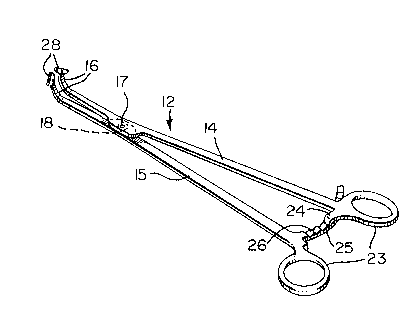Some of the information on this Web page has been provided by external sources. The Government of Canada is not responsible for the accuracy, reliability or currency of the information supplied by external sources. Users wishing to rely upon this information should consult directly with the source of the information. Content provided by external sources is not subject to official languages, privacy and accessibility requirements.
Any discrepancies in the text and image of the Claims and Abstract are due to differing posting times. Text of the Claims and Abstract are posted:
| (12) Patent: | (11) CA 1274408 |
|---|---|
| (21) Application Number: | 1274408 |
| (54) English Title: | DENTAL FORCEPS |
| (54) French Title: | DAVIER |
| Status: | Expired and beyond the Period of Reversal |
| (51) International Patent Classification (IPC): |
|
|---|---|
| (72) Inventors : |
|
| (73) Owners : |
|
| (71) Applicants : |
|
| (74) Agent: | |
| (74) Associate agent: | |
| (45) Issued: | 1990-09-25 |
| (22) Filed Date: | 1987-06-15 |
| Availability of licence: | N/A |
| Dedicated to the Public: | N/A |
| (25) Language of filing: | English |
| Patent Cooperation Treaty (PCT): | No |
|---|
| (30) Application Priority Data: | None |
|---|
ABSTRACT OF THE DISCLOSURE
The usual forceps used in a dental laboratory are
the straight or rectilinear devices commonly employed by the
medical profession. A better forceps design for use in dental
laboratories includes a straight body defined by a pair of arms
which are interconnected in a reverse scissors fashion ei.,
the jaws open when the handles of the forceps are pressed
towards each other, with loops defining handles at one end,
bent tips at the other end extending outwardly from the remainder
of the arms at approximately 45° to the plane of such arms,
and small jaws, each with a serrated edge, pivotally mounted
on the free ends of the tips for engaging the interior of a
crown to hold the latter. The jaws can pivot around axes
perpendicular to the axes of the tips, or around the
longitudinal axes of such tips. Rather than squeezing
inner and outer surfaces of a crown, the novel forceps
grip opposing surfaces of the interior of a crown.
Note: Claims are shown in the official language in which they were submitted.
Note: Descriptions are shown in the official language in which they were submitted.

2024-08-01:As part of the Next Generation Patents (NGP) transition, the Canadian Patents Database (CPD) now contains a more detailed Event History, which replicates the Event Log of our new back-office solution.
Please note that "Inactive:" events refers to events no longer in use in our new back-office solution.
For a clearer understanding of the status of the application/patent presented on this page, the site Disclaimer , as well as the definitions for Patent , Event History , Maintenance Fee and Payment History should be consulted.
| Description | Date |
|---|---|
| Inactive: IPC from MCD | 2006-03-11 |
| Inactive: IPC from MCD | 2006-03-11 |
| Inactive: IPC from MCD | 2006-03-11 |
| Inactive: CPC assigned | 2001-05-18 |
| Inactive: CPC removed | 2001-05-18 |
| Time Limit for Reversal Expired | 1997-09-25 |
| Letter Sent | 1996-09-25 |
| Grant by Issuance | 1990-09-25 |
There is no abandonment history.
Note: Records showing the ownership history in alphabetical order.
| Current Owners on Record |
|---|
| EDWARD DENIS PINDER |
| Past Owners on Record |
|---|
| None |